Natural Gas Market Changes
Natural gas has become a central subject of discussion within the energy market over the past several years. There are many reasons for this. First, the gas industry has experienced extraordinary success during the last decade. Horizontal drilling and the large-scale development of shale basins in the U.S. have become economically reasonable. Liquefied natural gas (LNG) technologies which have been around since the 1950s are now commercially viable. As a result, unlike other fossil fuels, natural gas is now widely used, and this usage continues to increase in most sectors of the modern economy: power generation, manufacturing, transportation, and more traditional areas, such as commercial and residential end-use consumption.
The LNG trade has expanded rapidly around the world, and interconnected networks of gas pipelines have and are still being developed inside and around Europe and Middle Asia. The natural gas industry is now facing a number of new challenges and opportunities related to both its demand and supply. On the demand side, the implementation of green energy policies will lead to a substantial increase in future gas demand. On the supply side, new natural gas resources are emerging around the world, mainly because of an increase in global LNG supply and the shale gas revolution. This unprecedented shift in the supply/demand balance for many countries is creating new market dynamics and altering gas pricing mechanisms. This article, the first in a two-part series that explores changes to the natural gas market, will provide a succinct overview of factors that will surely affect natural gas pricing mechanisms.
Natural Gas Market Macro Drivers
Effective analysis of the interaction between drivers of natural gas demand requires recognition of the uncertainty involved in this process. Simple forecasts or scenarios are unlikely to do justice to the complexities of the industry. Instead, an analytical framework is required to adequately capture the interaction between macro drivers of natural gas demand and alternative sources of gas supply. In this article, I lay groundwork for an effective analytical framework, based on the factors illustrated in Figure 1.
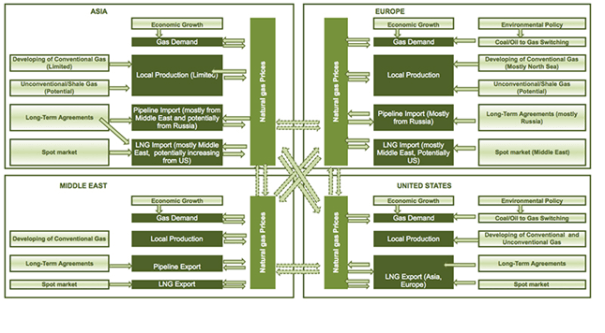
Figure 1: Macro Drivers of the Future Natural Gas Market
To understand the market’s current macro drivers, it is essential to comprehend a historical analysis of market movements over the last few years.
In North America, liquid spot and futures gas markets and a main natural gas hub have existed since the 1980s. In Europe, however, trading hubs began to succeed in 2008 as a result of the financial crisis. During this period, a combination of lower demand and a surplus of LNG created ideal conditions for hubs to develop liquidity and become the reference price for gas in Northwest European markets. In Asia, as a result of substantially rising international LNG price since the Fukushima nuclear accident in 2011, the Japan Crude Cocktail pricing mechanism has become no longer appropriate.
At the same time, the evolution of the global gas market is still unclear. The global market is still developing, and natural gas is evolving into a global commodity. Shale gas extraction is well developed in the U.S., and new technologies could be implemented in other countries with strategic shale gas resources, such as Ukraine and Poland. However, the development of unconventional gas reserves in these countries is under scrutiny, given existing state regulations and geopolitical tensions.
As the Asian demand for natural gas is vast, all of the large countries producing natural gas (with the exception of Netherlands and Norway) are interested in making long-term contracts with Asian buyers. The Asian market is a major area of interest for traditional regional producers like Qatar. The Russian company Gazprom, which has been trying to secure a long-term contract with China for many years, finally signed a 30-year contract with this country. The gas price from this contract, however, has not yet been discussed. North American and global natural gas market players consider the Asian market to be the major consumer of American LNG.
The European market is currently under the control of Gazprom. However, Europe could be switched to using natural gas from Central Asia, Qatar, and U.S. LNG. Besides, even with huge pessimism about the long-term development of the European shale market, it is still possible to produce shale gas in many European countries.
To gain an advantage in the industry, Algeria, Bolivia, Brunei, Egypt, Equatorial Guinea, Indonesia, Iran, Libya, Malaysia, Nigeria, Qatar, Russia, Trinidad and Tobago, the United Arab Emirates, and Venezuela established a gas cartel (Gas Exporting Countries Forum) in December 2008. This natural gas cartel was created to play a role within the natural gas market similar to the one OPEC has in the oil market. As of 2013, gas cartel members accounted for about 67%1 of the world’s gas proven reserves and 40%2 of production.
In the meantime, large natural gas producers that mostly delivered natural gas in Europe and Asia became interested in protecting their futures by keeping natural gas prices beneficial to themselves. Natural gas forecasts produced by credible agencies showed future natural gas prices at historically high levels. Traditional natural gas exporters counted on future profits. Major industry players were going to live in a new reality.
From 2008-2010, the majority of market players were ready to pay for futures that had a much higher price than the prices in the spot market, as shown in Figure 2.
Figure 2: Natural Gas Contract Pricing (created by ZEMA) Source: ICE, CME (http://www.theice.com/) (http://www.cmegroup.com/)
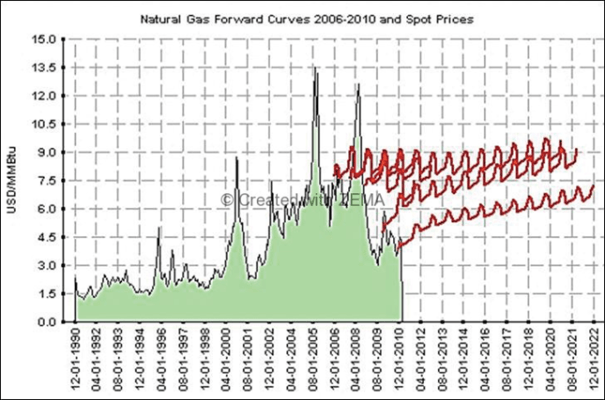
However, without a global LNG market, the gas cartel could not control quotas and prices, unlike OPEC, as natural gas has historically been a national or regional commodity.
This is one of many reasons why the “Gas OPEC” was not comparable to the influential, actual OPEC. Further explanations and more reasons are listed below:
There was no global gas market, as there was with oil. The challenge of transporting gas lead to tough competition for consumers, tearing the camp of suppliers apart. For example, Qatar wanted to increase exports of LNG to Europe. This was intended to disturb Gazprom, who viewed the European market as their primary sales outlet. In response, Russia was determined to conquer the Asian market, which they viewed as the major market for Qatari LNG. Internal and external political factors compounded the situation. Tensions in the Middle East and North Africa in 2011 engendered changes in regimes and altered the balance of power in these countries’ energy sectors. For example, the gas industry in Egypt and Libya, which was a part of the new gas cartel, experienced negative effects as a result of the Arab Spring. Iran, too, suffered from sanctions.
Differences between the policies of gas suppliers also did not support gas cartel development. For example, Russia tended to export pipeline gas under long-term contracts and thus was interested in sustaining year-round supplies at a preset price. The formula for gas prices used in long-term contracts is linked to oil products. In contrast, Qatar, the world’s leading exporter of LNG, was interested in fast sales at spot prices, which vary along with current market demand and are not fixed in the long term. As a result, Qatar avoided the real issues involved with developing a gas pricing discovery mechanism.
In 2008, prices of natural gas started to decline, as shown below. The global economy continued to deteriorate too, as most countries slipped deeper into a recession. Reduced OPEC supply helped to ease the downward slide of oil prices. However, a mechanism to keep the natural gas price from falling did not exist. Ongoing conflicts in the Middle East and the Russia-Ukraine natural gas disputes only revived some bullishness in the market. However, it would be wrong to underestimate the substantial changes in the global natural gas market that were occurring at the same time.
First, price movements were the same in different parts of the world, as shown Figure 3.
Figure 3: Natural Gas Price Movement (created by ZEMA) Source: ICE (http://www.theice.com/)
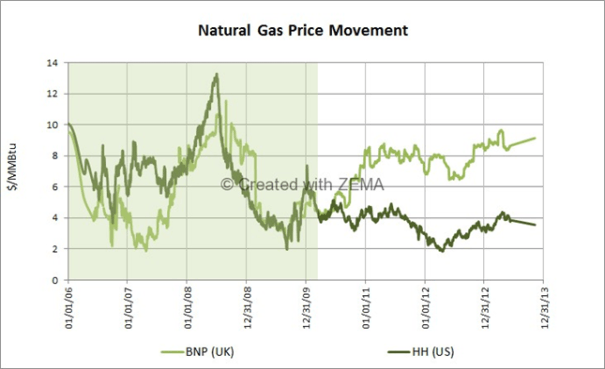
Second, as shown in Figure 4, natural gas and crude oil prices moved together before the end of 2008, as they were supposedly considered substitutes. Since 2009, natural gas and crude oil prices have not been strongly correlated.
Figure 4: Natural Gas and Oil Price Movement (created by ZEMA) Source: ICE (http://www.theice.com/)
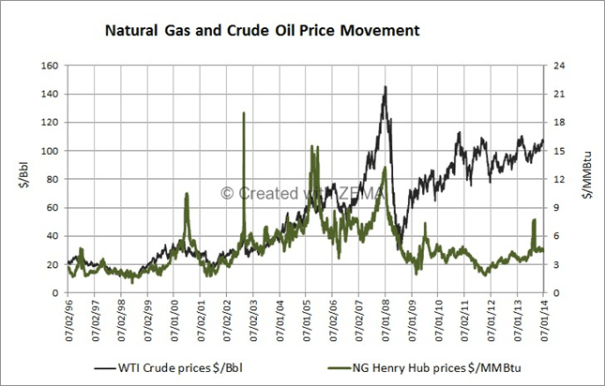
Third, substantial changes occurred in industry participants’ understanding of the LNG market. Historically, pipelines have played a critical role in connecting and balancing natural gas supply and demand, usually across vast distances. LNG technologies and the development of import/export terminals made long-distance natural gas transportation possible.
LNG was not a new concept in 2008. In 1964, the U.K. became the world’s first LNG importer and Algeria the first LNG exporter. Algeria has since become the world’s major supplier of LNG. Spain is another large importer. In 1969, Alaskan LNG was sent to Japan. Japan has also been receiving LNG exports from Indonesia’s Arun gas field since the late 1970s.
By 2008, North America’s substantial unconventional gas reserves and the rising Asian demand for natural gas altered the economics of LNG. Over the last several years, large scale tanker delivery has become economically feasible. With further LNG development, natural gas market players started to talk about natural gas as a global commodity. As a result, now, as shown in Figure 5, the U.S. is currently importing natural gas from Europe, the Middle East, Latin America, and Africa. The U.S. is exporting to Canada and Mexico, Europe and Asia, and Brazil and India.
Figure 5: U.S. Natural Gas Import and Export Source: EIA (http://www.eia.gov)
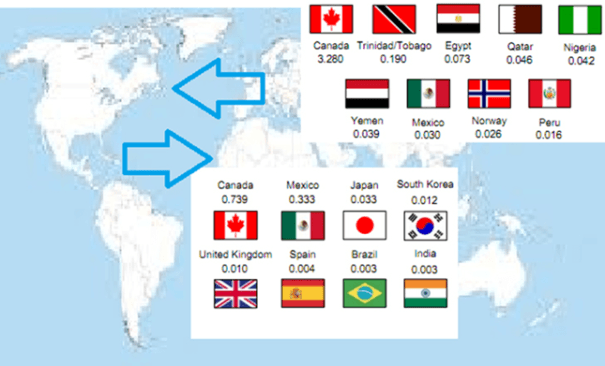
Current Global Supply, Including Shale Gas Development
The United States Is the Biggest Natural Gas Producer
The historical events in the global natural gas market that were discussed above have given way to present trends that will impact pricing structures in the industry. Current developments will be summarized below.
Drilling success in the U.S. and Canada is changing U.S. reserves, pricing structures, and the pipeline landscape—all so that valuable hydrocarbons can be brought forward to the market.
Upon achieving success in shale gas production, the U.S. has now become a net exporter of natural gas, exporting to Japan, Spain, Brazil, India and other countries around the world. LNG prices around the world support LNG exports from the U.S., as shown in Figure 6.
Figure 6: LNG Price around the World Source: FERC (http://www.ferc.gov)
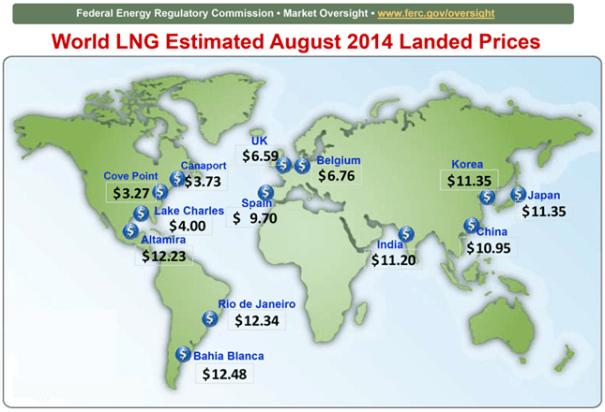
The U.S. Federal Energy Regulatory Commission (FERC) continues to receive multiple requests for the approval of plans to develop export LNG terminals, as shown in Figure 7.
Figure 7: Potential and Proposed LNG Terminals Source: FERC (http://www.ferc.gov)
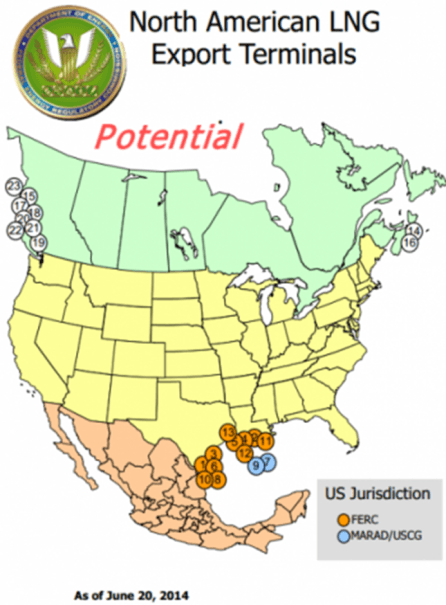
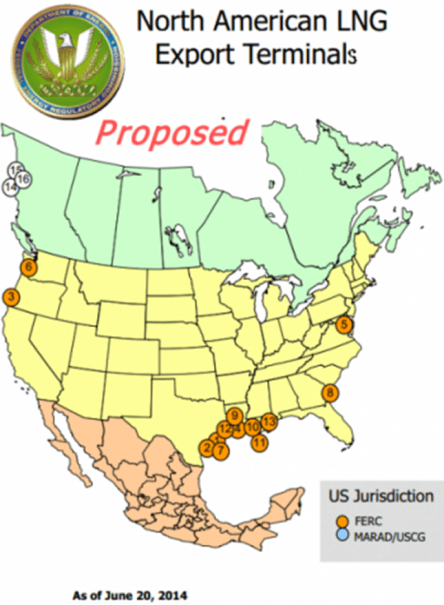
With numerous LNG export terminals under development, some energy companies have changed their vision of the world’s future to include not only Europe, Asia, and Latin America, but even Far North developments in North America. Some companies are now proposing gas-fired electrical generators based on delivered LNG instead of traditional transmission system expansions.
Market analysts and credible agencies have now factored in world-wide LNG delivery as a driver in their natural gas price forecasts. In these forecasts, the U.S. is assumed to be the biggest natural gas producer in the world ahead of Russia, Canada, North Sea countries, Iran, and Qatar. Asian and European markets are assumed to be major consumers.
Gazprom’s Hegemony in Europe
At the same time, Russia has continued conventional gas and pipeline transportation development, meeting around 30% of European natural gas demand with its exports. Gazprom’s control over hydrocarbons in the region has increased from its access to the Black Sea—a result of Russia’s annexation of Crimea in 2014.
As shown in Figure 8, Gazprom has and continues to export large volumes of natural gas to Europe.
Figure 8: 2013 Gazprom Natural Gas Export Source: Gazprom (http://www.gazprom.com/about/marketing/europe/)
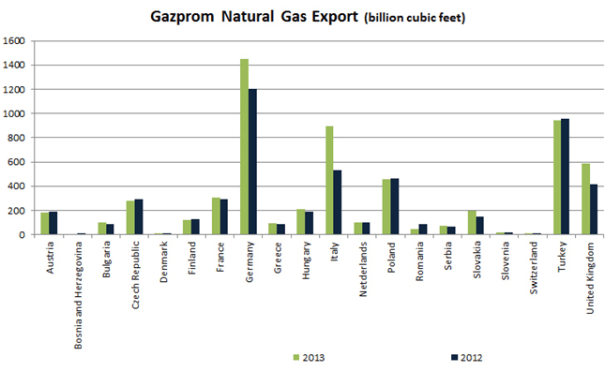
After the collapse of the Soviet Union, Russia began to experience some problems transporting gas to Europe. Heritage gas transportation systems from Russia to Europe started to become a headache. In 2006, Ukraine, which hosts the major gas pipeline between Russia and Europe, started a gas war about Russia’s gas monopoly through Gazprom. See the existing pipeline system in Figure 9.
Figure 9: Existing Gas Transportation System from Russia to Europe Source: GasTechNews (http://www.gastechnews.com/)
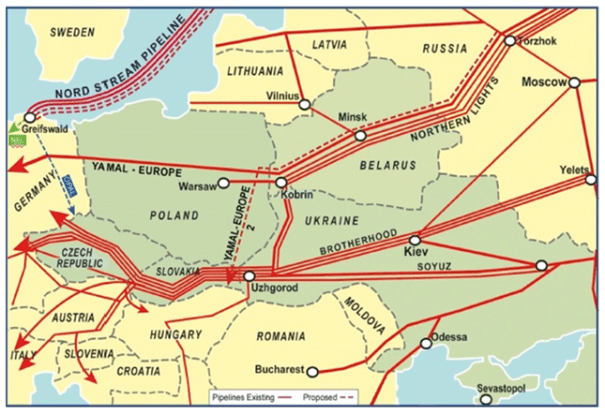
After the de-escalation of the Ukrainian-Russian conflict in 2006, new pipeline construction began throughout the Russian Northwest (Nord Stream) and South (South Stream), as shown in Figure 10.
Figure 10: Nord Steam and South Steam Pipelines Source: Deutsche Welle (http://www.dw.de)
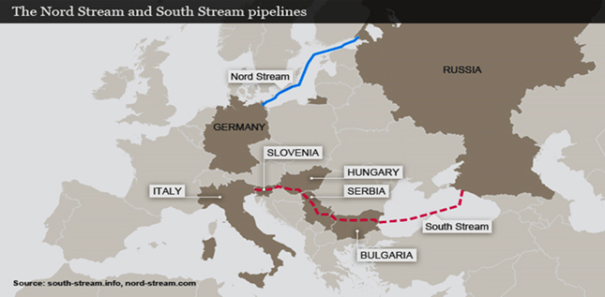
These pipelines were supposed to deliver gas to major European Gazprom consumers.
New pipelines were built to compete with the Nabucco project, which intended to deliver Caspian gas to Europe while bypassing Russia. Meanwhile, experts doubted the large-scale gas project was viable, as LNG supplies from the Middle East and potentially from the U.S. began to compete with Russian natural gas supplies. The global boom of shale gas development also posed a threat to Gazprom.
The development of the South Stream and North Stream pipelines came amidst tightening EU energy policies, which aimed to decrease the EU’s dependency on Russian gas, especially natural gas markets in Central and Eastern Europe.
Gazprom’s gas market was and continues to be relatively weak and controlled by the state. In comparison to the large-scale U.S. natural gas market, Gazprom’s pricing mechanism still links natural gas prices to crude oil. All European and Asian contracts have maintained the dependencies outlined in Figure 11 until now. Historically, crude oil prices drove European natural gas contracts by 67%, with a substantial input from Gazprom and an Asian input of 88%, according to the JCC (Japanese Customs-Cleared Crude Oil) indexation mechanism.
Figure 11: Natural Gas Contract Pricing Source: Alaska Natural Gas Transportation Project (http://www.arcticgas.gov/)
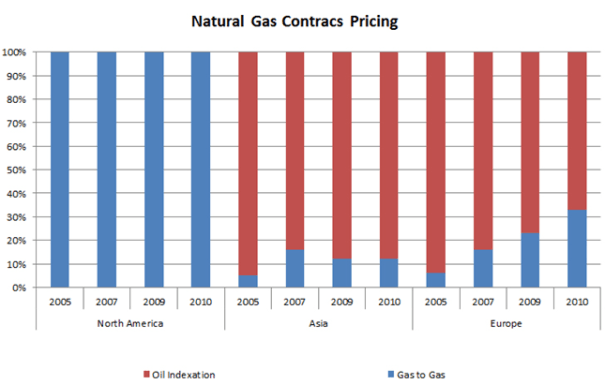
Gazprom has repeatedly stressed that shale gas development globally and decreasing European demand doesn’t pose any threat to its business. “Protecting” itself from the fictitious natural gas cartel described earlier and ignoring the realities of the global natural gas market, Gazprom continues to link natural gas contracts to crude oil prices. As a result, the difference now between American and European gas prices is substantial. Due to this divergence, liquefaction and tanker deliveries from the U.S. to Europe seem economically reasonable.
Other Big Players in the European Market
North Sea countries are also playing a very important role in the European market. Norway is the world’s third-largest exporter of natural gas after Russia, and Qatar produces 35% of European imports. As well, as of 2012, Norway is the sixth largest dry natural gas producer. However, North Sea oil and gas production has declined during the last few years after its peak from 1999-2004, as the region’s aging fields have become depleted.
In the Barents Sea, Norwegian Statoil and Russian Gazprom have developed the Shtokman natural gas and condensate field. However, in 2012, the project was indefinitely delayed due to technical and financial challenges.
Netherlands is also involved in North Sea natural gas production, creating 4% of European imports. Norway and Netherlands combined, however, export less than Russia, as shown in Figure 12.
Figure 12: Natural Gas Export (% from World Export) Source: The World Factbook – CIA (https://www.cia.gov/library/publications/the-world-factbook/)
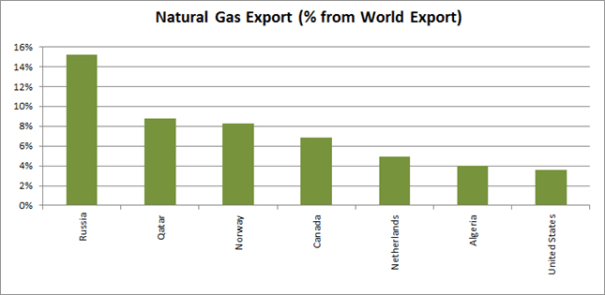
Changes in natural gas development have not been as dramatic for North Sea countries. The only issue to mention here is that shale methane production has been much lower in this region than was initially expected. Natural gas is still transported from the North Sea using traditional pipeline systems.
Central Asian, Middle Eastern, and North African Gas Fields
The Middle East contains substantial natural gas resources. Along with traditional natural gas producers such as Qatar, Iran, Syria, and Lebanon and Turkey, Central Asian countries like Kazakhstan and Tajikistan contain sizeable resources. Potentially, many of these countries will be able to deliver natural gas to European consumers via a new pipeline system from the Middle East. When this system is put in place, natural gas will flow into Europe from Saudi Arabia, Qatar, and Iran through Syria, Lebanon and Turkey, and Kazakhstan and Tajikistan. Many new pipelines that form a part of this network are presently under development, as shown in Figure 13.
Figure 13: Middle East Pipelines to Europe Source: ACD (http://acdemocracy.org/)
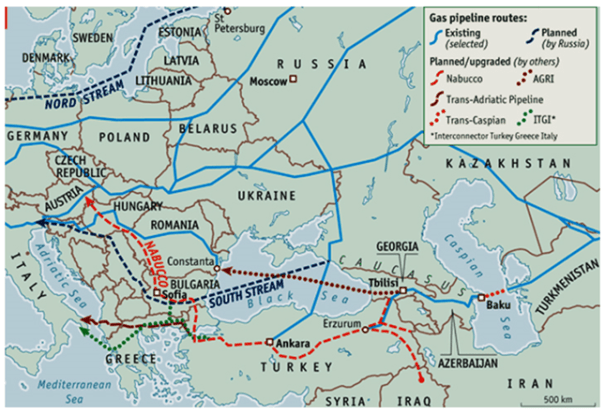
Some of the pipeline developments in the Middle East are already under construction. In the meantime, debates about the viability of new Asian pipelines in the Middle East continue. For example, Nabucco’s pipeline, which was supposed to deliver natural gas from Turkey to Austria, is no longer considered commercially viable.
Algeria, Libya, and Egypt in North Africa have the potential to supply more natural gas to European countries. According to EIA, these countries can provide about 44% of what Russia does today. However, problems with infrastructure and political instability decrease the probability of big changes.
New Possible Natural Gas Market Players
As shown in Figure 14, large shale gas formations exist in other parts of the world.
Figure 14: Shale Gas Basins around the World Source: Advance Resource International (http://www.adv-res.com/) [GD1]
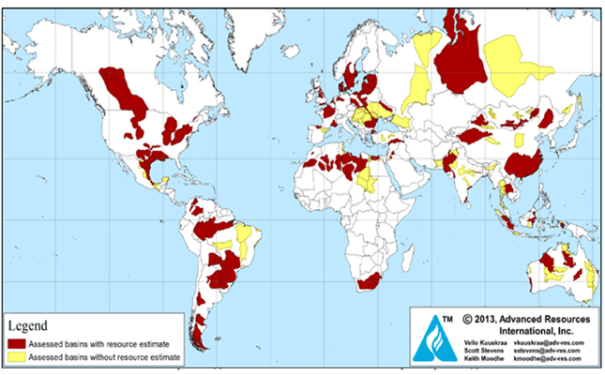
According to a range of different sources, China has substantial shale gas resources (the largest in the world, according to EIA). North and South Africa, South America, and Australia also have technically recoverable shale gas resources. Finally, shale gas formations exist in Europe, with the largest estimated reserves located in Poland, Romania, and Ukraine.
Shale basins are not only located in the U.S. China claims to have substantial shale gas deposits. Eastern European countries, especially Ukraine and Poland, have proven huge shale resources. Ukraine has Europe’s third-largest shale gas reserves, averaging 1.2 trillion cubic meters, according to different estimates. There are two potentially large shale gas fields and unconventional hydrocarbons in the Black Sea (Crimea). The Yuzivska gas field is located in the Donetsk and Kharkiv regions, and the Olesska field is in the Lviv and Ivano-Frankivsk regions.
Major improvements to shale gas extraction technologies that have been made between the last six to eight years are also impacting the global natural gas market. These technologies have been widely tested in the U.S. by international oil and gas companies. The involvement of these companies might potentially support fast and successful shale gas development in Ukraine in particular. For example, at the end of January 2013, Ukraine signed a 50-year shale gas production sharing agreement with Royal Dutch Shell; this agreement involves commercial shale gas extraction in the Yuzivska gas field by 2017. In addition, in November 2013 Chevron signed a 50-year agreement with the Ukrainian government to develop oil and gas in Western Ukraine. In the same month, the Ukrainian government signed another production-sharing agreement with a consortium of investors led by Italian energy company Eni to develop unconventional hydrocarbons in the Black Sea. Various oil companies, including Chevron, Shell, ExxonMobil, Repsol, and even PetroChina have shown interest in developing their offshore energy assets in Crimea.
Moreover, Ukraine has inherited a major pipeline system linking Russia to Europe. As North Stream is still being constructed and South Stream has yet to receive regulatory approvals, the Ukrainian pipeline system is the only dependable way for natural gas to flow from Russia to Europe. Only six month ago, Ukraine appeared to be a potentially powerful gas market player in Europe, while Russia’s Gazprom was losing control of the European gas market. Even now, with the escalation of the Ukrainian crisis, we cannot exclude Ukraine’s shale gas market development from the list of global market drivers.

